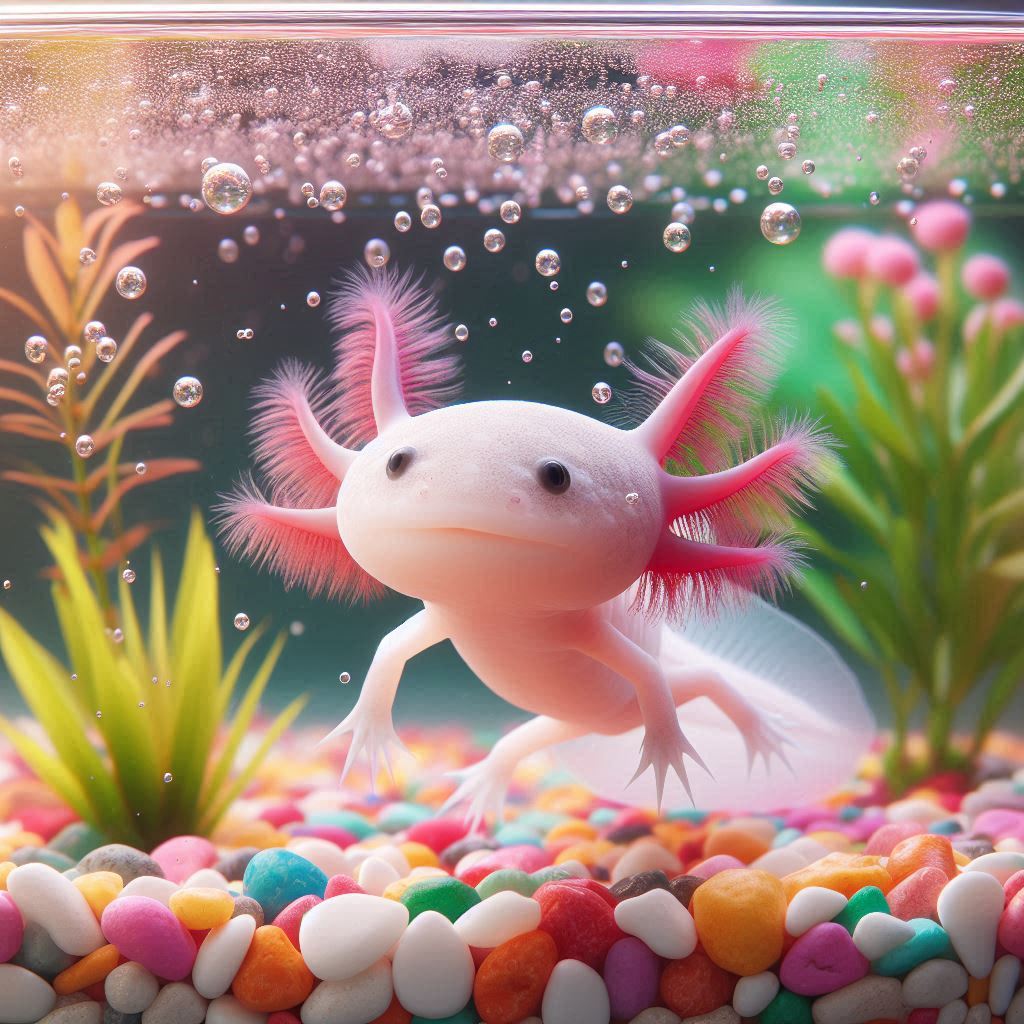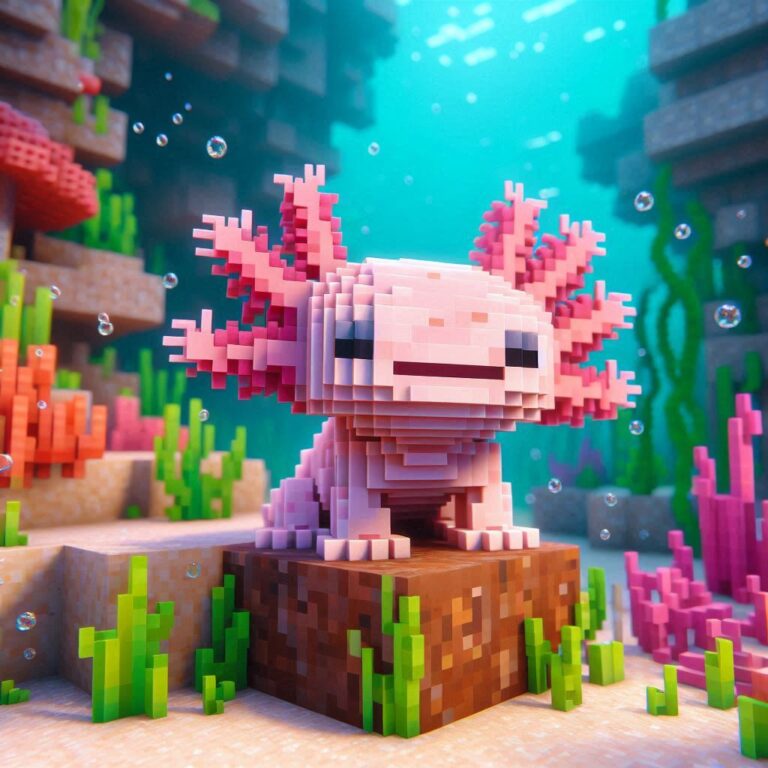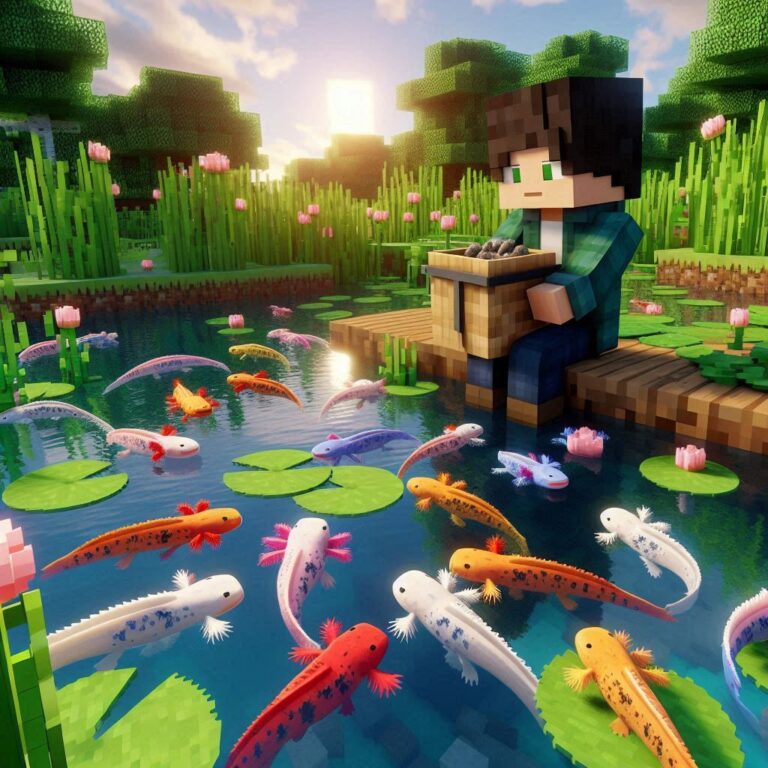
The dwarf axolotl, a captivating variant of the traditional axolotl, is a diminutive aquatic amphibian renowned for its charmingly small size and vibrant array of colors. Originating from selective breeding efforts, these creatures typically measure between 5 to 7 inches in length when fully grown.
Their compact size makes them popular among hobbyists and collectors alike, offering a manageable yet engaging pet experience. Dwarf axolotls exhibit remarkable regenerative abilities, capable of regrowing lost limbs and even repairing damaged organs—a testament to their resilience and unique biology.
With proper care and a suitable aquatic habitat, dwarf axolotls can thrive for up to 15 years, providing enthusiasts with years of fascination and enjoyment.
What is a Dwarf Axolotl?
The dwarf axolotl represents a charming variation of the beloved axolotl species, renowned for its compact size and unique traits. Unlike its larger counterpart, the dwarf axolotl has been selectively bred to exhibit smaller dimensions, typically reaching lengths of 5 to 7 inches when fully matured.
These diminutive creatures retain the distinctive features that make axolotls so intriguing, including external gills, a wide smile revealing rows of tiny teeth, and a streamlined body adapted for aquatic life.
Introduction to Dwarf Axolotls
Dwarf axolotls captivate enthusiasts with their diminutive size and diverse color variations, ranging from classic wild-type patterns to striking albino and melanoid forms.
Their natural curiosity and relatively docile nature make them fascinating pets, ideal for both beginners and seasoned aquarists. While originally developed through selective breeding in captivity, dwarf axolotls retain many of the remarkable regenerative capabilities of their larger relatives, able to regenerate limbs, tail segments, and even parts of their internal organs throughout their lifespan.
History and Origin
The history of the dwarf axolotl traces back to the selective breeding efforts aimed at producing smaller versions of the axolotl species, originally native to the lakes of Mexico, particularly Lake Xochimilco.
Over time, breeders focused on maintaining the unique characteristics of the axolotl while reducing its overall size. This selective breeding process has led to the development of various color morphs and patterns, expanding the diversity available to aquarists and researchers alike.
Scientific Classification
Scientifically classified under the genus Ambystoma and species Ambystoma mexicanum, dwarf axolotls belong to the class Amphibia and order Caudata, placing them within the broader family of Ambystomatidae.
This classification underscores their close relation to other salamanders and newts, emphasizing their evolutionary adaptations to aquatic habitats. Understanding their scientific classification provides insight into their biological traits, including their unique ability to remain in a larval state throughout their lives, a characteristic known as neoteny.
Dwarf Axolotl Care
Caring for dwarf axolotls involves creating a conducive environment that mimics their natural habitat while meeting their specific needs. These fascinating amphibians require attentive care to thrive.
Regular monitoring of water parameters, feeding schedules, and habitat maintenance are crucial aspects of their care routine. Ensuring a stable and clean environment promotes their health and longevity.
Tank Setup and Environment
Setting up the perfect tank for dwarf axolotls is essential for their well-being. A tank size of at least 20 gallons is recommended to provide ample space for movement and exploration. Use a fine gravel or sand substrate to prevent accidental ingestion during feeding.
Incorporating aquatic plants and hiding spots with driftwood or rocks helps create a naturalistic environment and reduces stress. Ensure the tank has a secure lid to prevent escapes, as axolotls are known to explore and can be surprisingly adept at finding small openings.
Water Quality and Filtration
Maintaining pristine water quality is paramount for dwarf axolotls. They are sensitive to water conditions, requiring a pH level between 6.5 to 8.0 and temperatures ranging from 16-18°C (60-64°F).
Invest in a quality filtration system suitable for the tank size to remove waste and maintain oxygen levels. Regular water testing and partial water changes (about 25% weekly) help prevent ammonia buildup and ensure a healthy aquatic environment.
Diet and Feeding
Dwarf axolotls are carnivorous and thrive on a diet rich in protein. Offer a variety of foods such as earthworms, bloodworms, brine shrimp, and commercially formulated axolotl pellets.
Feed them 2-3 times a week, adjusting the amount based on their size and appetite. Ensure all food items are appropriately sized to prevent choking or digestive issues. Consider occasional vitamin and calcium supplements to support their overall health and bone development.
By focusing on these key aspects of care—tank setup, water quality, and diet—axolotl enthusiasts can provide a thriving environment for their beloved aquatic companions, fostering a rewarding and enriching experience for both pet and owner alike.
Dwarf Axolotl Size and Lifespan
Understanding the size and lifespan of dwarf axolotls is essential for providing optimal care and managing expectations as a pet owner. These diminutive amphibians typically reach lengths between 5 to 7 inches (12-18 cm) when fully grown.
Despite their smaller size compared to standard axolotls, dwarf axolotls retain the distinctive features that make them beloved among aquatic enthusiasts, including their external gills and endearing facial expressions.
Growth Rate and Maximum Size
Dwarf axolotls exhibit a steady growth rate influenced by factors such as diet, water quality, and habitat conditions. While they may reach their maximum size of 5 to 7 inches within the first year or two, growth can vary among individuals.
Providing a nutritious diet and maintaining optimal tank conditions promote healthy growth and development. It’s important to note that environmental factors, including temperature and water quality, play significant roles in their growth trajectory.
Lifespan and Health Factors
With proper care and attention, dwarf axolotls can live for an impressive 10 to 15 years in captivity. Factors contributing to their longevity include maintaining stable water parameters, providing a balanced diet, and regular health monitoring.
Monitoring their behavior and appetite can offer early indicators of potential health issues, allowing for timely intervention by a qualified aquatic veterinarian if needed.
Common health concerns for axolotls include fungal infections, skin lesions, and issues related to water quality.
Ensuring a suitable environment with adequate space, proper nutrition, and consistent water quality management enhances their overall well-being and longevity. By investing in their care and understanding their unique biological needs, dwarf axolotl enthusiasts can enjoy many years of companionship with these fascinating aquatic creatures.
Dwarf Axolotl Habitat
Understanding the habitat requirements of dwarf axolotls is crucial for their well-being in captivity. These amphibians, bred from the native axolotl species, require specific environmental conditions to thrive.
Whether in their natural or captive habitat, providing a suitable environment is essential for their health and longevity.
Natural Habitat and Distribution
In their natural habitat, axolotls are endemic to the ancient lakes of Mexico, particularly Lake Xochimilco and Lake Chalco. These freshwater lakes are characterized by slow-moving or stagnant water with abundant aquatic vegetation.
Axolotls are primarily found in shallow waters near the lakebed, where they can easily access prey and find shelter among aquatic plants and debris.
Captive Habitat Requirements
Replicating a naturalistic habitat in captivity is essential for dwarf axolotls. A tank size of at least 20 gallons is recommended to accommodate their active swimming behavior and provide ample space for growth.
Use a fine sand or gravel substrate to prevent ingestion during feeding and provide hiding spots with live or artificial plants, driftwood, and rocks. Ensuring a secure lid is crucial, as axolotls are known for their curious nature and may attempt to escape if given the opportunity.
Temperature and Lighting
Maintaining the right temperature and lighting conditions is critical for the health and well-being of dwarf axolotls. They thrive in cooler water temperatures ranging from 16-18°C (60-64°F).
Avoid direct sunlight and use low-intensity aquarium lighting to simulate their natural habitat conditions. Consistency in temperature and lighting helps reduce stress and promotes natural behaviors, such as feeding and exploration.
By adhering to these habitat requirements—whether recreating their native environment or providing a well-designed captive habitat—axolotl enthusiasts can ensure their aquatic companions thrive and flourish in captivity. Understanding their natural behaviors and environmental needs enhances the overall experience of caring for these unique amphibians.
Dwarf Axolotl Colors and Variation
Dwarf axolotls exhibit a stunning array of colors and patterns, making them a popular choice among aquarists and collectors alike. Unlike their wild counterparts, which typically display a natural brownish hue with golden speckles (known as wild type), dwarf axolotls come in a variety of captivating color variations.
These color variations are the result of selective breeding efforts aimed at enhancing and diversifying their appearance while maintaining their unique characteristics.
Common Color Variations
Some of the most common color variations seen in dwarf axolotls include:
- Albino: Characterized by a white or pale pink body with pink eyes and translucent skin.
- Leucistic: White or pale with pinkish gills and dark eyes, lacking the dark pigmentation typical of wild type.
- Golden Albino: Similar to albino but with a golden-yellow hue instead of white.
- Melanoid: Predominantly black or dark-colored, lacking pigmentation on the body and sometimes exhibiting dark eyes.
Each color variation adds to the aesthetic appeal of dwarf axolotls, making them highly sought after among enthusiasts who appreciate their unique beauty and genetic diversity.
Genetic Traits and Breeding
Selective breeding plays a pivotal role in producing and maintaining these diverse color variations in dwarf axolotls. Breeders carefully select individuals with desirable traits, such as color intensity, pattern clarity, and overall health, to propagate specific color morphs.
Understanding axolotl genetics is essential for successful breeding programs aimed at producing consistent and high-quality offspring.
Breeding dwarf axolotls requires careful consideration of genetic inheritance patterns, including dominant, recessive, and co-dominant traits. Through controlled breeding practices and genetic testing, breeders can predict and produce offspring with desired color variations.
This process not only enhances the visual appeal of captive populations but also contributes to the genetic diversity and sustainability of dwarf axolotls in captivity.
Dwarf Axolotl Price
The price of dwarf axolotls can vary significantly based on several factors, making them accessible to a wide range of enthusiasts while also catering to collectors seeking rare color morphs.
Understanding these pricing factors is essential for those considering adding a dwarf axolotl to their aquatic collection.
Factors Influencing Price
Several key factors influence the price of dwarf axolotls:
- Color Variation: Rare and unique color variations such as melanoid or golden albino often command higher prices due to their rarity and visual appeal.
- Age and Size: Juvenile axolotls are generally more affordable than adults. Larger specimens, which may have developed more intense colors or larger size, can also be priced higher.
- Breeder Reputation: Established breeders with a reputation for producing high-quality axolotls, ensuring health, and genetic diversity, often charge premium prices for their specimens.
- Demand and Availability: Axolotls that are in high demand or less commonly available due to breeding success rates or seasonal availability can also affect pricing.
Average Cost and Availability
On average, dwarf axolotls can range in price from $20 to $100 or more, depending on the factors mentioned above. Standard color morphs like wild type or albino tend to be more affordable and readily available.
However, specialty color morphs or unique genetic traits may be priced higher due to their rarity and desirability among collectors.
Availability can fluctuate based on breeding success rates, seasonal variations in demand, and regional availability from breeders. It’s essential for prospective owners to research reputable breeders, attend local aquarium events or forums, and inquire about availability to find the right dwarf axolotl that fits their preferences and budget.
Dwarf Axolotl Facts

Dwarf axolotls are captivating creatures known for their unique traits and fascinating biology, making them a popular choice among amphibian enthusiasts. Here are some intriguing facts about these diminutive aquatic salamanders:
- Neoteny: Unlike most amphibians, dwarf axolotls retain their larval features throughout their lives, including external gills. This trait, known as neoteny, makes them appear perpetually youthful and contributes to their distinctive appearance.
- Regenerative Abilities: One of the most remarkable aspects of dwarf axolotls is their ability to regenerate lost limbs, tails, and even portions of their organs throughout their lifespan. This regenerative capability has made them valuable subjects in scientific research aimed at understanding tissue regeneration and potential medical applications for humans.
- Diverse Color Variations: From striking albino and golden albino to the dark and sleek melanoid, dwarf axolotls exhibit a wide range of color variations bred through selective breeding efforts. Each color morph adds to their visual appeal and has unique genetic characteristics.
Unique Regenerative Abilities
Dwarf axolotls are renowned for their unparalleled regenerative abilities, which surpass those of most vertebrates. They can regenerate not only limbs and tails but also portions of their spinal cord, heart, and other vital organs.
This remarkable capability stems from their cells’ ability to dedifferentiate and proliferate rapidly at the site of injury, forming new tissues and organs over time.
Scientists study axolotls to gain insights into human tissue regeneration, hoping to apply these findings to medical treatments for injuries and diseases.
Behavior and Interaction
Dwarf axolotls are known for their docile temperament and curious nature, making them intriguing pets.
While primarily solitary, they can recognize their owners and exhibit behaviors such as swimming near the tank’s surface to greet them during feeding times.
They are active at night, often exploring their habitat and searching for food. Providing them with a comfortable and enriched environment with hiding spots and appropriate tank mates can encourage natural behaviors and interactions.
Conservation Status
While dwarf axolotls bred in captivity are not currently endangered, their wild counterparts, the native axolotls of Mexico, face critical conservation challenges. Habitat loss, pollution, and invasive species threaten their existence in the wild.
Conservation efforts are underway to preserve their natural habitats and breeding populations, including initiatives to reduce pollution and restore their native lake ecosystems.
Captive breeding programs play a vital role in maintaining genetic diversity and ensuring the species’ survival for future generations to appreciate and study.
FAQs
Q. What is a dwarf axolotl?
A. A dwarf axolotl is a selectively bred variant of the axolotl, known for its smaller size and unique appearance.
Q. How big do dwarf axolotls get?
A. Dwarf axolotls typically grow to be 5-7 inches (12-18 cm) in length.
Q. What do dwarf axolotls eat?
A. They primarily eat protein-rich foods such as worms, small insects, and specialized pellets.
Q. How long do dwarf axolotls live?
A. With proper care, dwarf axolotls can live for 10-15 years.
Q. What temperature do dwarf axolotls need?
A. The ideal temperature range for dwarf axolotls is between 16-18°C (60-64°F).
Q. Can dwarf axolotls regenerate body parts?
A. Yes, they have the remarkable ability to regenerate lost limbs, spinal cord, heart, and other organs.
Q. Are dwarf axolotls endangered?
A. While wild axolotls are critically endangered, dwarf axolotls are bred in captivity and are not considered endangered.
Q. How much does a dwarf axolotl cost?
A. The cost can range from $20 to $100, depending on factors such as color and age.
Q. What size tank do dwarf axolotls need?
A. A minimum of a 20-gallon tank is recommended for a dwarf axolotl.
Q. Can dwarf axolotls live with other fish?
A. It’s not advisable to keep dwarf axolotls with other fish, as they can be aggressive or become stressed.
Conclusion
In conclusion, dwarf axolotls stand out not only for their diminutive size and captivating array of colors but also for their remarkable biological traits and unique place in both scientific research and aquatic pet culture. From their perpetual larval features to their extraordinary regenerative abilities, these amphibians continue to intrigue and inspire enthusiasts and researchers alike.
As pets, dwarf axolotls require conscientious care to thrive, necessitating attention to their specialized habitat needs, dietary requirements, and monitoring of their health. Their docile temperament and interactive behaviors make them rewarding companions for those willing to invest in their care.

Hassan Shah carries over four years of hands-on expertise in caring for axolotls, guided by his cherished companion ‘Little Bruno,’ a thriving axolotl under his attentive care for three years.



